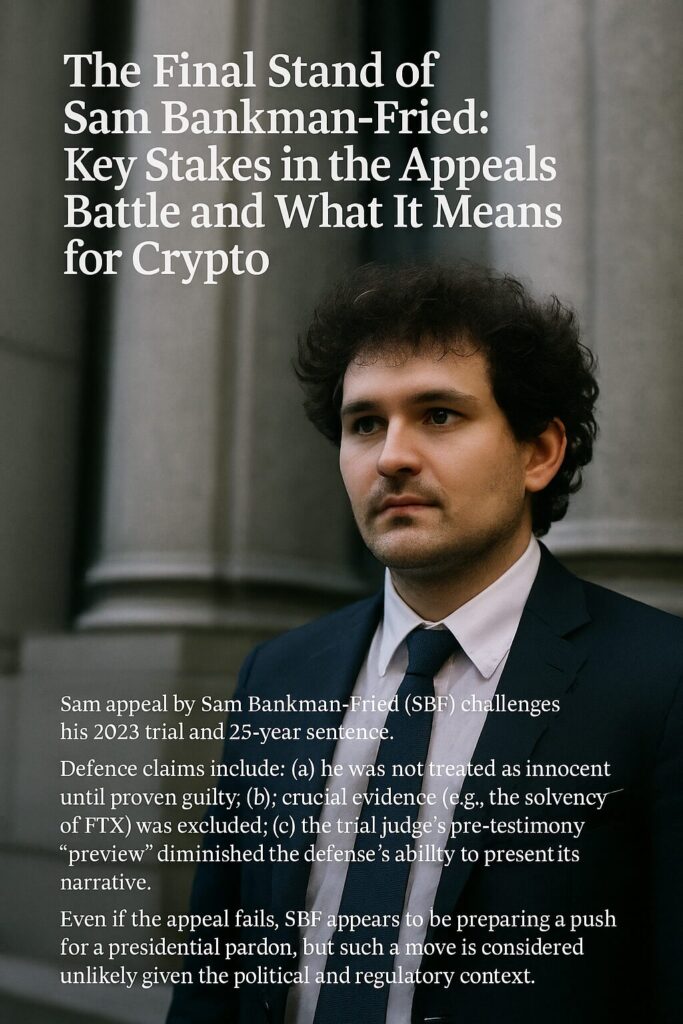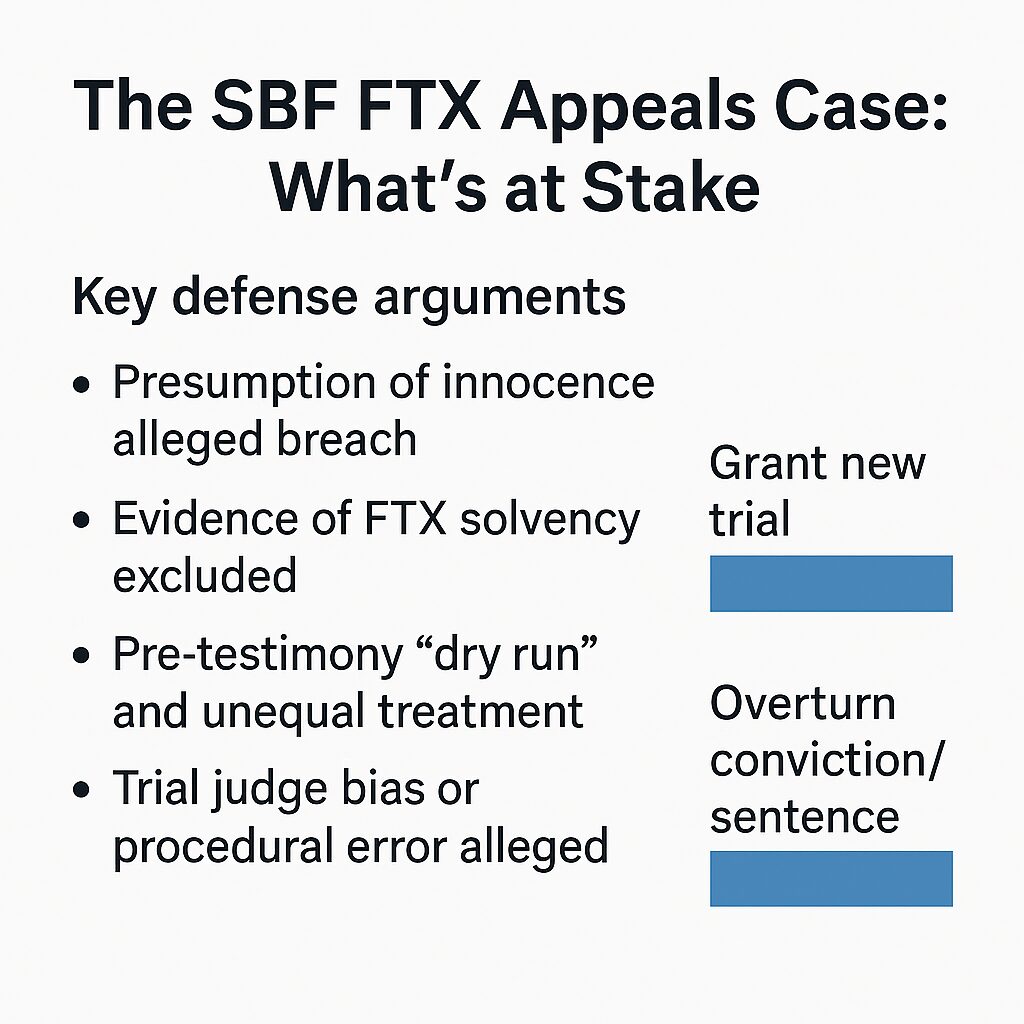
Main Points :
- The appeal by Sam Bankman‑Fried (SBF) challenges the fairness of his 2023 trial and 25-year sentence.
- Defence claims include: (a) he was not treated as innocent until proven guilty; (b) crucial evidence (e.g., the solvency of FTX) was excluded; (c) the trial judge’s pre-testimony “preview” diminished the defence’s ability to present its narrative.
- The appeal hearing before the United States Court of Appeals for the Second Circuit (“Second Circuit”) is seen as an uphill battle, with the court generally reluctant to overturn jury verdicts absent clear error.
- The outcome will have wider implications for the crypto industry: executive accountability, the role of trial procedures in major fraud cases, and investor sentiment.
- Even if the appeal fails, SBF appears to be preparing a push for a presidential pardon, but such a move is considered unlikely given the political and regulatory context.
1. Background: What Happened to FTX and SBF
In November 2022, FTX, once one of the largest crypto exchanges, collapsed amid allegations of misused customer funds and improper transfers between FTX and its sister hedge fund, Alameda Research.
In November 2023, Bankman-Fried was convicted by a jury on multiple counts of wire fraud, conspiracy and money-laundering related to an ~$11 billion fraud scheme.
In March 2024 a judge sentenced him to 25 years in federal prison.
For crypto investors and blockchain practitioners, this case signified a regulatory and legal reckoning: a major figure in decentralised finance (or ambitiously centralised crypto) being held personally accountable, sending a signal that the industry is maturing toward higher legal risk.
2. What Is at Stake in the Appeal

SBF’s legal team is asking the Second Circuit to either grant a new trial or overturn the conviction/abolish the sentence.
Key defence arguments
- Presumption of innocence alleged breach: The appeal brief states that from day one the narrative adopted by the prosecution (and takeover counsel at FTX) assumed SBF had stolen billions and sank FTX, leaving no room for him to present an alternative.
- Evidence of FTX solvency excluded: The defence claims the jury was not allowed to see evidence that FTX had assets sufficient to repay customers, undermining the “insolvency” narrative.
- Pre-testimony “dry run” and unequal treatment: At trial, SBF testified before the jury, but it is argued that a prior “preview” of his testimony (without a jury present) gave the government an unfair advantage in cross-examination. Judges during the hearing asked whether this procedure impaired SBF’s right to a fair trial.
- Trial judge bias or procedural error alleged: The defence contends that Lewis Kaplan, the trial judge, made comments and rulings that improperly limited the defence’s ability to present its case, particularly around the “advice of counsel” defence.
What the appeals court will decide
- Whether the trial court committed reversible error. That is, did the alleged mistakes affect the verdict outcome sufficiently to warrant a retrial?
- Whether the procedures employed met the constitutional standard of a fair trial, including the jury’s opportunity to hear relevant evidence and the neutrality of the judge.
- Whether the record supports overturning the verdict or whether the appeals court must instead affirm the conviction. Historically, appellate courts are reluctant to disturb jury verdicts absent egregious error.
3. Recent Developments: What’s Happening Now
- On 4 November 2025, the oral argument was heard by a three-judge panel before the Second Circuit.
- The judges posed skeptical questions of the defence. For example, one asked: “It may not have been a perfect trial… but there was robust evidence against SBF. Would the excluded testimony have made a difference?”
- Media and legal commentators see the appeal as a steep uphill climb. One noted: “Unless there are multiple errors which, taken together, deprive the defendant of a fair trial, they will strain to uphold the behaviour of the trial judge.”
- The panel also apparently questioned the enormous forfeiture order against SBF (some $11 billion) as part of the sentence, asking whether such a large number had “penal justification.”
- On the strategic front: SBF and his team have publicly posted a document titled “Where Did the Money Go” claiming that FTX was never insolvent.
- Political angle: SBF’s defence team appears to be laying the groundwork for seeking a presidential pardon if the appeal fails, though observers deem the odds low given his donations to Democrats and the current administration’s likely stance.
For blockchain practitioners and those hunting new crypto-assets or platforms, this case underscores that legal/regulatory risk is very much real—and that near-term developments (such as appeal outcomes, industry regulatory response, investor sentiment) may ripple into the broader industry.
4. Implications for Crypto, Blockchain and Investment Opportunities
Executive accountability and governance
The case amplifies that crypto-platform founders and executives can be held personally liable—even if they argue it was “risk management failure” rather than intentional fraud. That raises the bar on internal controls, governance, auditing, and transparency for any project seeking to attract serious capital.
Trial procedure as precedent in crypto fraud litigation
The appellate outcome may influence how future crypto fraud cases are litigated in the U.S.—especially with respect to evidentiary standards (such as exclusion of defence evidence), jury instructions, and judges’ discretion. Any sign that the appeal panel is reluctant to disturb the verdict may reinforce prosecutorial leverage in crypto cases.
Investor sentiment and asset-opportunities
- For investors seeking new crypto assets, the legal environment becomes part of the risk assessment. Platform/asset models that hinge on weak governance or opaque fund flows may carry higher risk of regulatory and legal blow-back.
- For income opportunities, those engaged in decentralized finance (DeFi) or tokenised asset models must increasingly consider legal/regulatory compliance, not just yield curves or tokenomics. A compliance failure could wipe out yield potentials.
- For practical blockchain applications, the SBF/FTX saga is a cautionary tale: innovation without built-in transparency, auditing, and compliance frameworks may falter. Projects that embed strong governance, independent audits, on-chain transparency, and regulatory alignment may have a competitive advantage in raising institutional capital.
Market signalling
If the appeal is affirmed, it may increase risk-perception across the crypto market—especially for exchanges, lending platforms, yield aggregators, and algorithmic stablecoins. Conversely, if there is a surprise reversal or significant legal nuance favouring SBF, one might see short-term sentiment relief—but likely accompanied by regulatory clarifications.
5. What to Watch Next
- Panel decision by the Second Circuit: While not expected immediately, the number and tone of questions during oral argument may hint at the judges’ leanings. Some commentators note if the hearing is brief and pro-forma, affirmation is more likely.
- Pardon dynamics: If the appeal fails, will there be renewed lobbying for a presidential pardon? The political calculus around crypto actors remains fluid, especially given recent pardons in the sector (e.g., Changpeng Zhao of Binance).
- Industry regulation flow-on: The case may trigger regulatory reforms or enforcement escalations—platforms may pre-emptively strengthen compliance frameworks to mitigate risk.
- Asset-market response: Watch for sentiment shifts in crypto markets—particularly for platforms or tokens associated with lending, mix of native exchange operations, or large founder equity stakes.
- Precedent effect: The outcome may influence how future crypto founders structure governance, disclosures, and legal defences—especially in jurisdictions subject to U.S. litigation risk or cross-border enforcement.
6. Conclusion
For practitioners, investors and blockchain project builders, the appeal of Sam Bankman-Fried is more than a high-profile court case—it is a key moment in the maturation of the crypto ecosystem. The outcome will send strong signals on legal risk, executive accountability, governance standards and industry-wide compliance expectations.
If the appeal fails, it underscores that no amount of innovation will immunise actors from stringent legal standards once funds are mismanaged and customer deposits jeopardised. If, surprisingly, the appeal succeeds (though odds appear low), it may embolden some risk-taking—but also likely provoke tighter regulatory frameworks in response.
In either scenario, the message is clear: innovation without institutional-grade governance and full transparency may no longer be viable in the evolving crypto-finance landscape. For those hunting new assets, revenue streams or real-world blockchain applications, the lesson is that you must incorporate robust legal/regulatory foundations into your model from day one.

